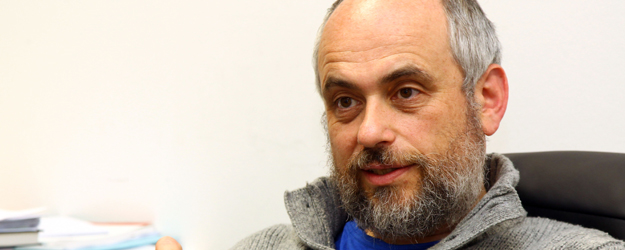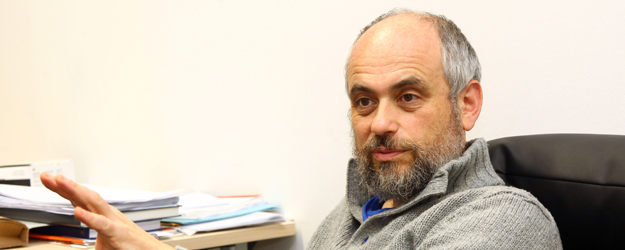9 January 2015
Research into fundamental symmetries and a unique nationwide cooperation between Johannes Gutenberg University Mainz (JGU) and the Helmholtz Association have brought Professor Dmitry Budker to Mainz. He will be heading up the Matter Antimatter Symmetry section at the JGU-based Helmholtz Institute Mainz, which collaborates with the GSI Helmholtz Center for Heavy Ion Research in Darmstadt.
Professor Dmitry Budker clears a seat. "Do sit down, please." He then maneuvers himself carefully past the two bicycles leaning against a shelf in the room to wash a couple of cups. Budker is not the only person in his temporary office at the JGU Institute of Physics. He introduces a colleague from Poland who looks up with a smile over the laptop on his knees and a guest from Russia who is working at a PC at the window.
"We always have a lot of visitors," explains Budker. "Two young Americans are coming over this summer and we are also expecting a professor from Australia. I think we cooperate with pretty much every country on the planet. We just need Antarctica to make up the set."
Helmholtz Institute Mainz
Cooperation is an important aspect as it was cooperation that brought Budker from the renowned University of California in Berkeley to Johannes Gutenberg University Mainz in early 2014. Here he is in charge of one of the research sections at the Helmholtz Institute Mainz (HIM) founded in 2009, which is gradually taking form in a new building just a few hundred meters away.
The Helmholtz Institute Mainz is the first institution to be run jointly by the Helmholtz Association and a German university. This collaborative project involves Mainz University on one side and the GSI Helmholtz Center for Heavy Ion Research in Darmstadt on the other. The researchers involved are planning to work together to investigate the structure, symmetry, and stability of matter and antimatter. In the near future, 60 scientists will be researching fundamental aspects of physics and chemistry at HIM. Budker will be one of them.
Budker will be heading up the Matter Antimatter Symmetry (MAM) section, which will focus on fundamental symmetries and interactions. Among other things, Budker and his team will be considering the still puzzling relationship between matter and antimatter. One conjecture is that equal amounts of matter and antimatter were created during Big Bang. Theoretically their mass would have been converted entirely into energy in the course of their interaction, meaning that they should have annihilated each other. But this does not seem to be the case. There is still plenty of matter out there. In fact, the Milky Way appears to be composed of it. So what happened to the rest of the antimatter? Is it possible that there was originally more matter than antimatter, in other words, was there asymmetry at the outset?
Russia, USA, Germany
Budker has been looking into violations of fundamental symmetry for quite some time. It goes back to his time in the former USSR, where he was born. He studied at the State University of Novosibirsk in western Siberia. He worked there until 1988 as a junior researcher at the Institute of Nuclear Physics.
He then transferred to Berkeley where his academic career began to take off. He received numerous awards, including one for his outstanding doctoral dissertation, and by 2003 he held an eminent Miller Professorship. It was at Berkeley that he came into contact with leading scientists such as Saul Perlmutter, holder of the Nobel Prize in Physics, or Steven Chu, who worked as Barack Obama's Secretary of Energy.
"I lived for 25 years in Russia and for another 25 years in California," summarizes Budker. Will he stay for 25 years in Mainz now? "Well," he says with a smile on his face, "even as a professor you need to retire at some point."
Always new ideas, new people
Budker's work at the Helmholtz Institute Mainz will be focused on high-precision measurements of the fundamental symmetries in the natural world. These measurements enter into the realms of nuclear, molecular, and optical physics. For decades, researchers around the world have been studying the violations of symmetry that have been identified in connection with the weak nuclear force, one of the four fundamental interactions in nature along with gravity, electromagnetism, and the strong nuclear force.
However, Budker and his team are by no means limited to this one field. "Different people keep coming up with new ideas so we try out a lot of stuff. Outsiders may find it a bit chaotic, but we stimulate each other. That works well." For example, his colleague from Poland with the laptop on his knees is investigating how diamonds could be used to measure magnetic fields.
Getting things started
Even in this room with the bicycles and the wash basin in the corner, there seems to be a palpable feeling that something remarkable is in the offing. The new FAIR accelerator for antiproton and ion research currently being built at GSI in Darmstadt will make an entire series of new experiments possible. Budker is also involved in the Precision Physics, Fundamental Interactions, and Structure of Matter (PRISMA) Cluster of Excellence at Johannes Gutenberg University Mainz and he is a member of the QUANTUM group at the JGU, in which several institutes of Mainz University are collaborating. When the HIM building will be finished, Budker will be moving once again, although this time around he will not have very far to go.
He is settling in in Mainz. "I am spending a lot of time learning German," says Budker in English, without disguising the fact that he is more than happy that he will not be forced to converse with his colleagues in German. This is one of the few challenges he feels he is not yet quite capable of mastering.


